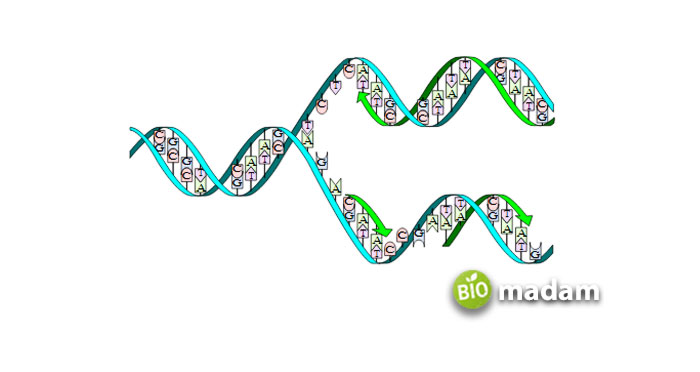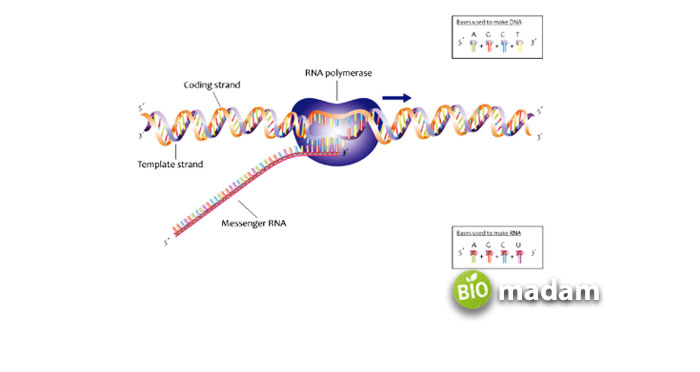DNA and RNA are the basic components of nucleic acid that are vital to eukaryotes and prokaryotes. They contribute to development and reproduction by synthesizing other cell components, such as several types of proteins. DNA replication and transcription are two important processes occurring in the nucleus. They contribute to the multiplication of DNA and genes and RNA production from DNA. Let’s tell you all the differences between DNA replication and transcription.
Comparison Table
| Characteristics | DNA Replication | Transcription |
| Definition | Formation of daughter DNA strands | Formation of RNA from DNA |
| Objective | Transfer characteristics of parents to off-springs | Transcribe specific genes into the RNA |
| Occurrence | S phase | G1 and G2 stages |
| Enzymes | Helicase and DNA polymerase | RNA polymerase |
| Primer | RNA primer | Not required |
| End Product | Daughter strands | mRNA, tRNA, rRNA |
What is DNA Replication?
The word replication means the act of reproducing or copying. DNA Replication indicates the reproduction and duplication of DNA.
The biological process of creating two identical copies of DNA from a single original DNA molecule refers to DNA replication in molecular biology. DNA replication happens in all living things and is the primary mechanism for biological heredity.
DNA replication guarantees that each new cell receives a copy of the DNA and is necessary for cell division during tissue growth and repair. It is crucial because the cell’s unique ability to divide makes it essential.

The Fundamental Concept of DNA Replication
DNA replication is a semiconservative process; each double helix strand is a model for creating a new, complementary strand. One beginning molecule converts into two “daughter” molecules in this process, each having a new and an old strand to create a double helix. DNA replication occurs within the cytosol of cytoplasm in prokaryotes, while in eukaryotes, it occurs in the nucleus.
Steps in DNA Replication
DNA replication consists of three steps. These are initiation, elongation, and termination.
Initiation
The first part of the process is known as initiation or unzipping. The helicase enzyme unzips DNA as the initial step in DNA replication. It allows for the reading of the DNA nucleotides and the formation of a complementary strand.
DNA synthesis begins at specified locations, or “origins,” along the DNA strand that contains particular coding sections. Splitting DNA strands leads to forming a “Y” shape replication fork. The two split strands serve as models for creating the new DNA strands. DNA primase plays a fundamental role in the process. It makes a small RNA primer that serves as the DNA polymerase’s “kick starter.”
Elongation or Extension
When DNA Polymerase is bound to the two unzipped strands of DNA (also known as the template strands), it begins synthesizing new strands of DNA identical to the templates. Adding free nucleotides to the primer’s 3′ end is the only way DNA polymerase can lengthen it.
There are two strands: the leading strand and the lagging strand. The leading strand is the one that points from the 3′ to 5′ direction (towards the replication fork). The second strand is the lagging strand which points in the 5′ to 3′ direction (opposite to the replication fork). These two strands duplicate differently due to their distinct directions. The primase enzyme produces a little RNA fragment known as a primer, which attaches to the leading strand’s end.
The primer serves as the DNA synthesis’s beginning point. A, C, G, and T are new complementary nucleotide bases that DNA polymerase adds to the leading strand of DNA as it “walks” along it in the 5′ to 3′ orientation. This type of replication is continuous replication.
Okazaki fragments (DNA Cubes or Chunks) migrate in a 5′ to 3′ direction and bind to the lagging strand. A discontinuous replication requires the eventual assembly of Okazaki fragments at the end.
Termination
The process of extending the new DNA strands continues until either two replication forks collide and then break or until there is no longer any DNA template strand to replicate (i.e., at the end of the chromosome). This collision is unregulated.
Exonuclease, an enzyme, removes the primer when all the bases reach their final destination (A with T, C with G).
The primer’s gaps are subsequently filled in with additional complementary nucleotides. DNA ligase then connects all fragments to form a single, complete strand through DNA sequencing. The new strand is proofread to ensure the unique DNA sequence is error-free. After replication, the newly created DNA immediately forms a double helix.
What is Transcription?
In genomics, transcription involves making copies of a gene’s DNA sequence in RNA. The messenger RNA (mRNA) copy carries the DNA-encoded protein information for the gene. When creating the encoded protein, mRNA travels from the cell nucleus to the cytoplasm. In simpler terms, one can say a translation from one language to another is similar to transcription. Although DNA is more stable, RNA is still a common biological unit.

The Fundamental Concept of Transcription
Transcription marks the start of gene expression. Each gene in your genome has its transcriptional regulation. After transcription, RNA molecules in all eukaryotic cells must undergo processing, which includes splicing, adding a 5′ cap and a poly-A tail to each end, and other steps.
Steps in Transcription
Initiation
The initiation RNA polymerase binds to the DNA molecule and proceeds down the DNA strand until it finds a promoter sequence. The transcription start locations are those. The nucleotides on each DNA strand are thus fully revealed as the DNA double helix unwinds. This template can create a new mRNA.
Elongation
The template strand receives ribonucleotide additions, enabling the development of mRNA. The polymerase creates an RNA molecule from complementary nucleotides as it “reads” this template one base at a time, forming a chain that extends from 5′ to 3′. The RNA transcript includes the same data as the non-template (coding) strand of DNA, but uracil (U) rather than thymine (T).
Termination
When RNA polymerase comes across a terminator sequence, transcription terminates. Then RNA polymerase gives access to DNA sequence or template. There is less knowledge about how eukaryotes terminate transcription than bacteria, but the process involves cleaving the new transcript and adding adenines to its new 3′ end without using a template.
Difference between DNA Replication and Transcription
Definition
DNA Replication
DNA replication creates two daughter strands, each of which includes half of the original DNA double helix.
Transcription
Transcription is the process of producing RNA by using DNA genes and alleles as a template.
Essential Objective
DNA Replication
DNA replication aims to protect the next generation’s whole genome.
Transcription
Whereas the transcription process aims to transcribe specific genes into RNA.
Occurrence
DNA Replication
It occurs during the cell cycle’s S phase to prepare for cell division along the DNA strands.
Transcription
Alternatively, transcription occurs in the cell cycle’s G1 and G2 stages to set up protein translation along one strand of DNA.
Enzymes
DNA Replication
In DNA replication, helicase and DNA polymerase serve the central purpose.
Transcription
On the other hand, RNA polymerase plays a significant role in transcription transcriptase.
Primers
DNA Replication
It needs an RNA primer to begin DNA replication.
Transcription
However, transcription does not require any primer to start the process.
End Product
DNA Replication
DNA replication results in the formation of two daughter strands.
Transcription
At the same time, transcription results in end products like non-coding RNA, mRNA, tRNA, and rRNA.
The Bottom Line
DNA replication and transcription are important processes in living organisms. DNA replication in prokaryotes and eukaryotes leads to the formation of daughter DNA strands. It allows chromatin and chromosomes to replicate and produce more DNA. On the other hand, transcription is the production of creating RNA from DNA strands. They facilitate reproduction and help in the synthesis of other cellular components. Thus, both processes are critical to maintaining the normal anatomy and physiology of the body.
FAQs
What is the major difference between DNA replication and DNA transcription?
DNA replication refers to the duplication of DNA strands to form more DNA. On the contrary, transcription leads to the formation of one strand from double-stranded DNA.
What is DNA replication in short?
DNA replication is the process through which the DNA is copied into the cells. It plays a major role in cell division, providing enough material to be distributed into the daughter cells through mitosis and meiosis.
What is the purpose of transcription?
Transcription allows the cell to create RNA copies from double-stranded DNA. This RNA carries the genetic information to produce protein within the body. RNA enables the transfer of information to the cytoplasm, where proteins are made.

Anna has completed her degree in Pharmacy from the University of Hawaii. She is serving as a research assistant in a pharmaceutical company. She had a great interest in writing blogs, traveling to different parts of the US, and trying delicious recipes in her spare time.


It’s so useful to all biology students